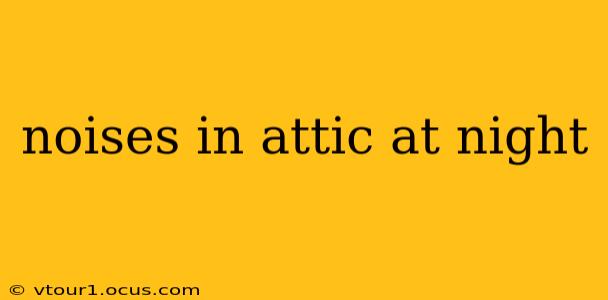The unsettling creaks, scrapes, and scurries emanating from your attic at night can be genuinely unnerving. That quiet space above, usually forgotten, suddenly becomes a source of intrigue, fear, and a whole lot of questions. This comprehensive guide will delve into the common culprits behind those mysterious attic noises, helping you identify the source and alleviate your concerns.
What are the common causes of noises in the attic at night?
This is often the first question people ask when faced with strange attic sounds. The answer, thankfully, rarely involves ghosts or other supernatural phenomena. The most frequent culprits are far more mundane, though still requiring investigation.
-
Animals: Squirrels, raccoons, rats, mice, and birds are all common attic invaders. Their movements – scurrying, scratching, nesting – create distinct noises. Squirrels, in particular, are known for their energetic activity, which can sound quite loud in the quiet of night.
-
House Settling: Older homes, especially, can produce creaking and groaning sounds as the structure shifts and settles throughout the day and night. Temperature changes also contribute to this expansion and contraction, leading to noticeable noises in the attic.
-
Wind: Strong winds can cause vibrations in the attic, leading to rattling sounds from loose objects, vents, or even the roof itself. This is especially true in areas with exposed or poorly insulated attics.
-
Plumbing and HVAC Systems: Pipes expanding and contracting due to temperature fluctuations, or the whirring and clanking of your HVAC system, can travel through the house and be particularly noticeable in the quiet of the night. Leaks or loose connections can amplify these sounds.
-
Debris: Loose materials, such as old insulation, stored items, or even debris blown into the attic by wind, can shift and bump against each other, creating rustling or scraping sounds.
What animals might be making noises in my attic?
Identifying the specific animal causing the disturbance requires careful observation and listening.
-
Rodents (Mice & Rats): These creatures typically make scratching, squeaking, and scurrying noises. You might also notice droppings or gnaw marks.
-
Squirrels: Squirrels are more active and boisterous than rodents. Their noises are often louder and more varied, including rustling, scampering, and even chattering.
-
Raccoons: These larger animals create more significant noises, including banging, thumping, and even tearing sounds as they move around and potentially damage attic structures.
-
Birds: Birds might create chirping, fluttering, or pecking sounds. They often nest in attics, leaving behind feathers and nesting materials.
How can I identify the source of the noise without entering the attic?
Before venturing into the attic, take steps to safely identify the source of the noise from the ground level.
-
Listen Carefully: Pay attention to the timing, frequency, and type of noise. Is it consistent, intermittent, high-pitched, or low-pitched? Try to pinpoint the location in the attic where the sound seems to originate.
-
Visual Inspection (from the outside): Check your roofline for any signs of animal entry points, such as holes or damaged areas. Look for droppings or other evidence of animal activity.
-
Observe: Watch for any signs of animal activity near your house. Do you see animals running along the roofline or entering/exiting the house?
-
Use a Listening Device: A sensitive microphone or even a recording device could help amplify and pinpoint the sound source.
Is it safe to go into the attic to investigate the noises?
Entering the attic should only be done with proper precautions. Never enter alone, always have someone else present. Wear appropriate safety gear, including sturdy shoes, gloves, and a flashlight. Inspect the attic for structural damage or hazards before proceeding. If you suspect a dangerous animal infestation, contact professional pest control.
What should I do if I find animals in my attic?
Animal removal should generally be left to professionals, especially if you're dealing with raccoons or other potentially aggressive animals. They are equipped to handle the situation safely and effectively, ensuring both your safety and the humane treatment of the animals.
What if the noises aren't caused by animals?
If you've ruled out animals, the next step is to inspect your house's structure. Look for loose roof tiles, deteriorated flashing, or other potential sources of wind noise. Check your HVAC system for any loose parts or leaks. Finally, consider that the sounds might simply be your house settling, which is perfectly normal, particularly in older homes.
By carefully considering these possibilities and taking appropriate steps, you can effectively pinpoint the source of those unnerving attic noises and regain peace of mind. Remember, safety should always be your top priority. If unsure about any aspect, professional assistance is always recommended.
